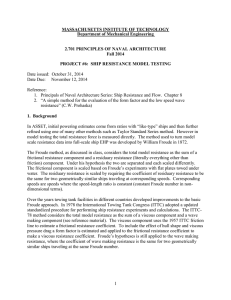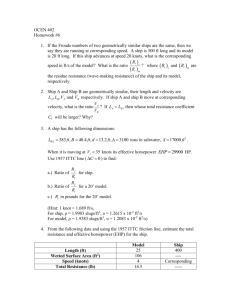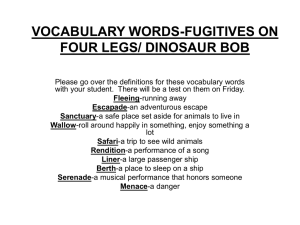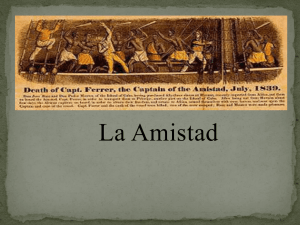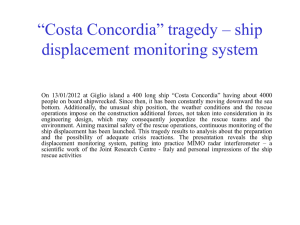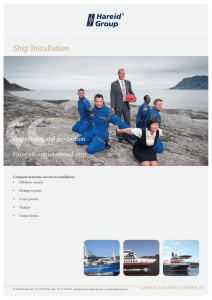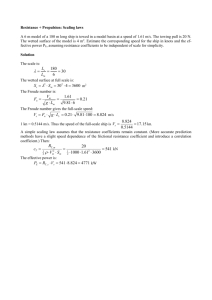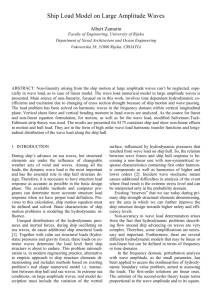Resistance and Powering of Ships
advertisement
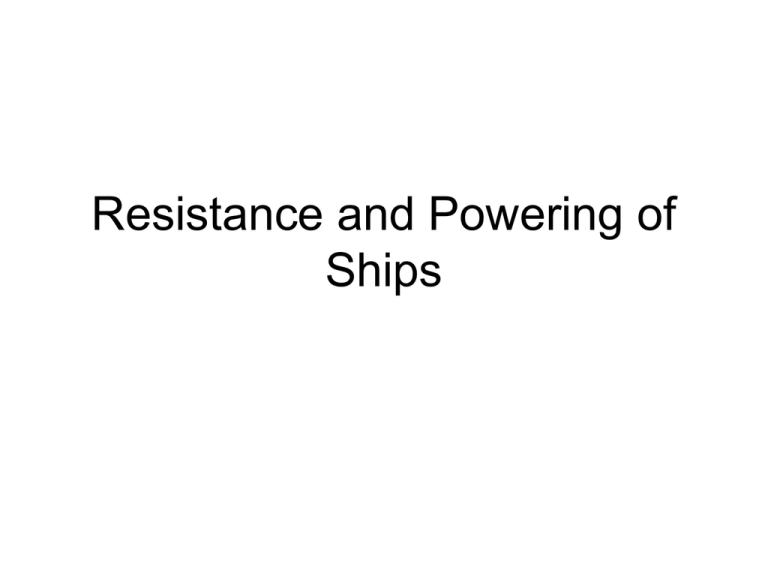
Resistance and Powering of Ships Considerations • • • • Required Power Select Power Plant Determine amount of FO storage KG Calculation Power = Resistance * Speed • RT = RF + RR • RT = Total Resistance • RF = Frictional Resistance – Boundary Layer • RR = Residuary Resistance – Wave Making Resistance – Eddy Making Resistance – Air Resistance Complete Physical Equation • • • • • • R = f( L, V, ρ, ν, g ) L – Length on waterline V – Velocity ρ – mass density of water ν – viscosity of water g – gravitational acceleration Froude • Model testing (1867) • 3’, 6’ 12’ models towed in open water • Observed that wave patterns related to ship resistance • Similar regardless of model size • Similar to full size ship at corresponding speed • Speed length ratio V/√L Laws of Comparison • Model Test Conducted • Measured resistances must be expanded to their corresponding resistances of the full scale ship corresponding to chosen model speeds • Large # of variables, extensive testing • Need to reduce the number of quantities to be examined by use of “dimensional analysis,” regrouping of variables Wave Patterns & Eddy Making Resistance Equation Rewritten: VL V R CT 1 f , f Re,Fr 2 Lg 2 SV Froude Number – associated with wave making resistance Reynolds Number – frictional resistance Resistance coefficient uses wetted surface instead of length Geometric Similarity λ = Ls/LM, BS/BM, Ts/ TM, … FnS = FnM ( V / √gL)S = (V / √gL)M VS/VM = √gSLS / √gMLM = √LS / √LM = √λ Therefore the corresponding model speed is: VM = VS / √λ What about Reynold’s Number? RnS = RnM ( VL / ν )S = ( VL / ν )M VS/VM = (LM/Ls)(νS/νM) If we assume the viscosities of the liquids are nearly equal… Vs / VM = LM / LS = 1 / λ Or VM = VS λ This requires model speed to be greater than the ship speed, test at Froude Speed Example 20’ model of 720’ ship λ = 720 / 20 = 36 If model is tested at Reynold’s Speed, assume ship speed to be 24 kts VM = (24)(36) = 864 kts What about Froude speed? VM = 24 / √36 = 4 kts How can both equations be satisfied? 2 components – RF = frictional resistance, RR = residuary resistance Model testing measures RT Froude Number is used to scale RR Reynolds Number is used to predict RF Studies done towing flat plates, equating surface areas CF = 0.075 / (log10Rn-2)2 (ITTC 1957) Correlation Allowance • Not exact • Additive to water resistance coefficients • Accounts for air, hull roughness, missing hull appendages • Use ITTC 1957 equation Coefficients Dimensionless Divide each term by ½ ρSV2 CT = CF + CR + CA Expanding Model Resistance to the Ship 1. Tow model at the corresponding speed VM = VS / √λ and measure model towing force or total model resistance (RTM) 2. Calculate the model’s total resistance coefficient CTM = RTM/1/2ρMSMVM2 3. Calculate model’s Reynold’s number RnM = VMLM / νM and model’s frictional resistance coefficient CFM = f(RnM) (ITTC equation) 4. Calculate model’s residuary resistance coefficient CRM by subtraction 5. According to law of comparison, CR of the ship equals that of the model CRS = CRM 6. Calculate ship’s Reynold’s number (RnS) and ship frictional resistance coefficient (CFS), using ITTC equation 7. Calculate ship total resistance CTS = CFS + CRS + CA 8. Calculate ship total resistance RTS = CTS(1/2 ρS SS VS2) Speed Length Ratio • Wave making resistance limits ship speed • Amplitude of waves is function of energy expended to generate them • Critical speed length ratio VS/√LS = 1.34 • When a surface ship attempts to exceed this speed, “climbing a hill of water” Bulbous Bows • D.W. Taylor experiments with bulbous bows at higher V/√L range from 0.9 to 1.9 and showed reduced resistance due to a newly created pressure pattern in area of bow wave (1907) • T. Inui’s (1962) research showed reduction in resistance due to wave cancellation and speed augmentation at lower Froude numbers • Other research indicated an alteration in flow characteristics around bow and along the bottom of the bulbous form is the source of the reduction


